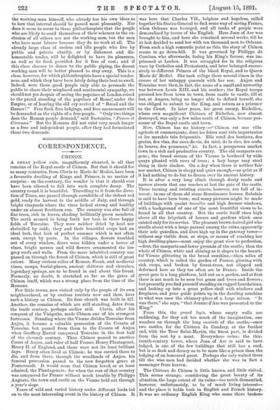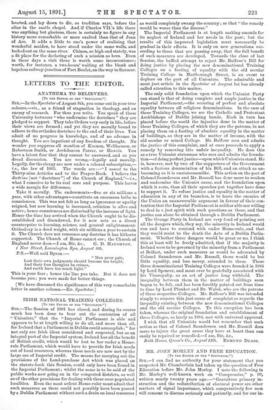CORRESPONDENCE.
C HINON.
A GREAT yellow ruin, magnificently situated, is all that remains of the Royal castle of Chinon. But that it should for so many centuries, from Clovis to Marie de' Medici, have been a favourite dwelling of Kings and Princes, is no matter of surprise : on the contrary, the wonder is that it should ever have been allowed to fall into such complete decay. The country round it is beautiful. Travelling to it from the direc- tion of Tours, one passed through cornfields of the richest red gold, ready for harvest in the middle of July, and through bright vineyards where the vines looked strong and healthy under an almost Southern sun. The country was also full of fine trees, rich in leaves, shading brilliantly green meadows. The earth seemed to bring forth her best in these happy fields of Touraine. They were neither dried by heat nor shrivelled by cold; they and their beautiful crops had an ideal look, that look of perfect summer which is not often seen, except by poets. In the villages, flowers tumbled out of every window, doors were hidden under a bower of vines, bright mosses and wild flowers ornamented the low grey roofs and walls. From the more inhabited country one passed on through the forest of Chinon, which is still of great extent. Many curious relics of Roman, Frank, and medieval times, camps, burial-places, ancient chciteauz and churches, legendary:springs, are to be found in and about this forest. Formerly, no doubt, it stretched as far as the gates of Chinon itself, which was a strong plate from the time of the Romans.
Few little towns, now visited only by the people of its own neighbourhood, or by curious tourists now and then, have such a history as Chinon. Its first church was built in 427. Another, the remains of which are still standing, dates from the tenth century, perhaps earlier still. Clovis, after his conquest qf the Visigoths, made Chinon one of his strongest fortresses. Standing where the Vienne divides Touraine from Anjou, it became a valuable possession of the Counts of Touraine, but passed from them to the Counts of Anjou when Geoffroy Martel conquered Touraine in the first half of the eleventh century. Thus Chinon passed to another Count of Anjou, and ruler of half France, Henry Plantagenet, Henry II. of England, and those were not its least brilliant days. Henry often lived at Chinon: he was carried there to die, and from there, through the woodlands of Anjou, his funeral procession passed to the now forgotten grave at Fontevrault. It would seem that Chinon loved, or at least admired, the Plantagenets ; for when the rest of that country was conquered for France without much trouble by Philippe Auguste, the town and castle on the Vienne held out through a year's siege.
Years of wild and varied history under different lords led on to the most interesting event in the history of Chinon. It was here that Charles VII., helpless and hopeless, called. together his States-General to find some way of saving France,.
when Orleans was besieged, and all ranks of people were- demoralised by terror of the English. Here Joan of Arc was brought to him, and here she remained several weeks, till he at last decided to send her with ten thousand men to Orleans..
From such a high romantic point as this, the story of Chinon. seems to go down-hill. It was governed by Philippe de Comines, who afterwards, losing his King's favour, was im- prisoned at Loches. It was struggled for in the religious wars by Catholics and Protestants, and later belonged awoke- sively to different Princes of the blood Royal, and to Queen_ Marie de' Medici. She took refuge there several times in the. course of her unhappy quarrels with her son. Anjou and Touraine were then, in fact, the scene of a small and unworthy
war between Louis XIIL and his mother; the Royal troops,. pursued her from town to town, from castle to castle, till at
last, at Angers, being no longer able to defend herself, she- was obliged to submit to the King, and return as a prisoner- to the Court. In later years, her great enemy, Richelieu,.
whose own magnificent Château of Richelieu, now almost. destroyed, was only a few miles south of Chinon, became pos- sessor of the Royal castle and town.
Now, Chinon has no history :—" Chinon eat une ville- agricole et commercante, dont les foires sont tree importantete et lea marches tree frequentes. Elle vend des bestiaux, des grains, des vine, des e,aux-de-vie, du mid, de la cire, des ceufs, du beurre, des pruneaux," 8,:e. In fact, a prosperous market, town in a rich and productive country. The old ramparts are gone; the broad stream of the Vienne is bordered by wide quays planted with rows of trees; a lazy barge may steal along in their shadow. On a day when there is neither fair- nor market, Chinon is sleepy and quiet enough,—as quiet as if it had nothing to do but to dream over its ancient history.
It is after a very long climb through dusty roads and narrow streets that one reaches at last the gate of the castle..
These turning and twisting streets, however, are full of in- terest: in one of these old stone Renaissance houses, Rabelais. is said to have been born; and many pictures might be made of buildings with quaint tourelles and high dormer windows, with a background of one of the most beautiful views to be found in all that country. But the castle itself rises high above all the labyrinth of houses and gardens which once
existed only for its service. The pleasant brown-haired girl who strolls about with a large parasol among the ruins, apparently, their sole guardian, and lives high up in the gateway tower.—
without any visible door, or steps, or means of reaching her high dwelling-place—must enjoy the great view to perfection, —first, the ramparts and lower grounds of the castle; then the- whole of Chinon, white and shining as it slopes to the beauti- ful Vienne glittering in the broad sunshine,—then miles of country, which is called the garden of France, glowing with rich crops, and broken by forest-trees, not clipped and. deformed here as they too often are in France. Inside the great gate is a long platform, laid out as a garden, and at first there is not much to be seen but grass and trees and flowers ; but presently you find yourself standing on rugged foundations,.
and looking up into a great yellow shell with windows and' fireplaces, and your guide points up in the dazzling sunshine- to what was once the chimney-place of a large saloon. "It. was there," she says, "that Jeanne d'Arc was presented to the Kin g."
From this, the grand logis, whose empty walls are- saddening, for they ask too much of the imagination, one wanders on through the long enceinte of the castle,—once two castles, for the Château du Coudray, at the further- end, with the Tour Saint-Martin, the finest part, is divided from the rest by a moat. Everywhere ruins : the thir- teenth-century tower, where Joan of Arc is said to have lodged, is one of the few buildings that still has a roof,.
but is so dark and dreary as to be more like a prison than the lodging of an honoured guest. Perhaps she only waited there till the wise men had decided whether she was in fact a, messenger from heaven.
The Cheteau de Chinon is little known, and little visited...
This seems strange, considering the great beauty of its. situation, the large extent of its ruins—too much dismantled, however, unfortunately, to be of mach living interest-- and the place it holds both in English and French history. It was no ordinary English King who came there broken.
hearted, and lay down to die, as tradition says, before the altar in the castle chapel. And if Charles VIL's life there was anything but glorious, there is certainly no figure in any history more remarkable or more exalted than that of Joan of Arc. It adds a little to one's power of realising that wonderful maiden, to have stood under the same walls, and looked out on the same river. Chinon, so high and stately, was a fit place for the declaring of such a mission as hers. Even in these days a visit there is worth some inconvenience; worth, for instance, a two-hours' waiting at the blank and hopeless railway-junction of Port Boulet, on the way to Sammur.



































 Previous page
Previous page